#pathtozerocarbon, #sustainability
03 – Toward Zero Carbon Architecture
With the built environment responsible for roughly 50% of human-caused emissions globally, the design and construction industry is racing to decarbonize toward zero carbon architecture – balancing carbon emissions with carbon offsets and sequestration. ‘Zero’ is deceptively simple, but so far carbon neutrality claims and certifications are true only under strict circumstances and within very limited boundaries. This post will explore expanding the boundaries so we can track real progress toward zero carbon architecture, including supporting frameworks and research.
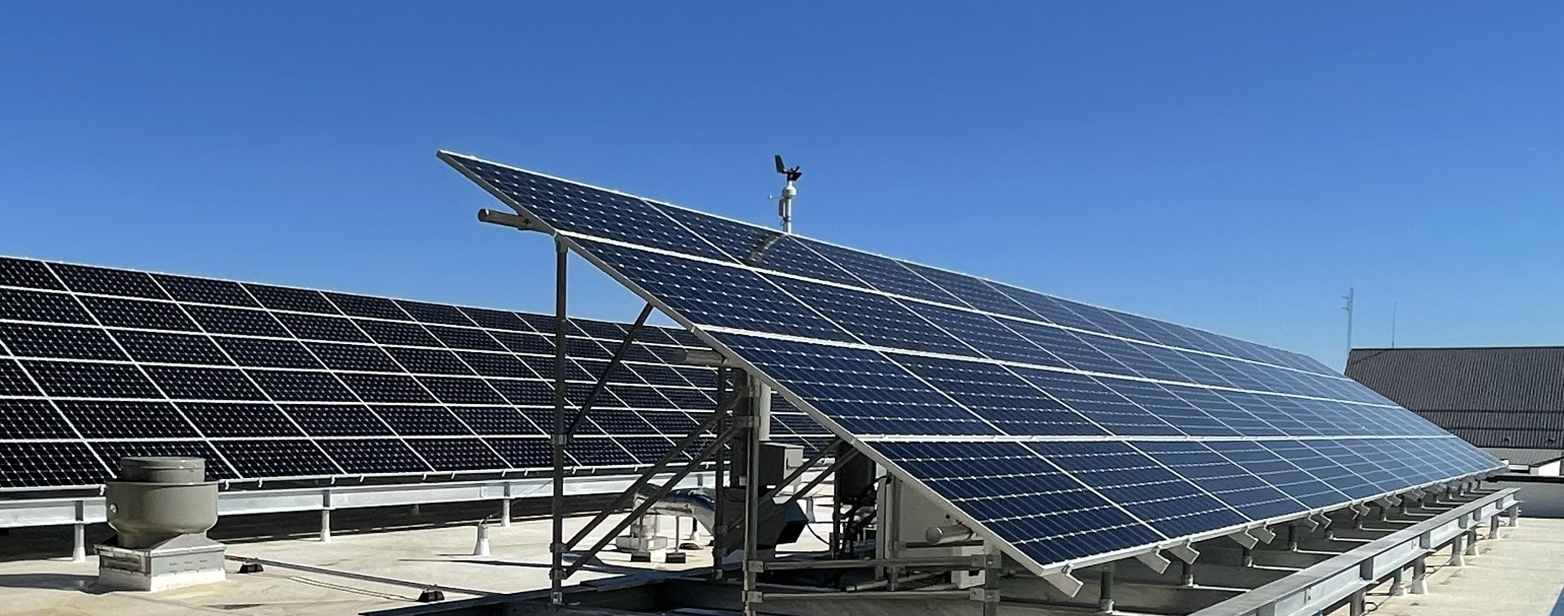
On-site solar energy is an important piece of zero carbon architecture but balancing annual energy use to zero is only one of the efforts necessary to get there.
Beyond Net Zero Energy
For the past 50 years, the buildings industry focused on energy use reduction as a proxy for action on pollution and, more recently, climate change. Buildings were designed to maximize daylight use, control solar heat gains using shading strategies, limit energy use through insulation, efficient mechanical systems, and generate energy with on-site renewables such as solar panels. The loftiest target has been to build a net zero energy (NZE) building that produced as much energy on site as used over a one-year period.
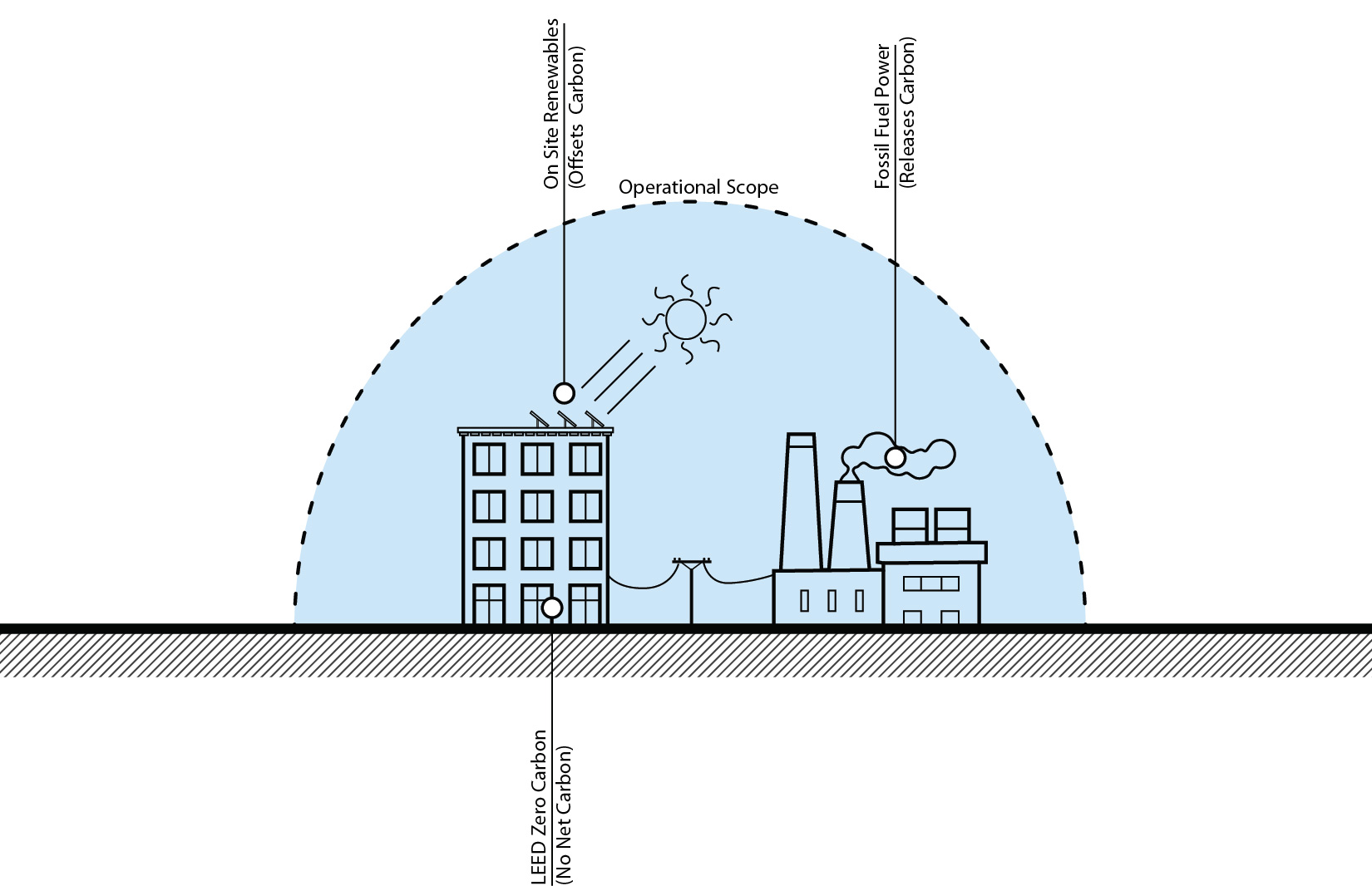
Many advanced buildings pursue net-zero energy goals, resulting in significant carbon emissions. As we rapidly decarbonize toward carbon neutrality we need to include a wider boundary encompassing many other important emissions sources.
This limited scope boundary has helped improve energy performance, but important voices have continually reminded us that net zero energy is not carbon neutrality. NZE buildings typically draw electrical power during times when less renewable energy is available and the grid uses carbon intensive “peaker” plants – fossil fuel power plants brought online to temporarily handle peak electricity loads. Including time of use carbon emissions means that many NZE building are not likely to be carbon neutral even for operational energy.
Energy efficiency and net-zero energy are still extremely important for 4 main reasons:
- Reducing energy use still reduces carbon emissions
- Reduced energy demand means existing electricity generation sources can be used for electrifying transportation
- Reduced energy demand also reduces the need to build new renewable energy sources, including associated costs and embodied carbon emissions
- Energy efficient electric systems inch toward zero carbon every year since the electricity grid is rapidly decarbonizing
While energy efficiency and electrification are key strategies to address operational carbon emissions, there remains other sources of carbon emissions that demand attention. The materials used to construct buildings require substantial carbon emissions to produce, emissions that will take decades or centuries to offset through energy use reductions. Advanced mechanical systems also contain refrigerants with high global warming potential that leak into the atmosphere. As we attempt to define zero carbon architecture, we first need to broaden our scope to include all sources of building-related emissions.
Missing emissions – An Example
A 2019 collaborative study between PAE, MKA and LMN asked how much carbon went unreported using the LEED v4.1 System as a framework. The study compared carbon emissions calculated with LEED (life cycle impacts of building elements and carbon associated with energy use) against all available carbon emissions data on a highly efficient mass-timber building. The analysis included:
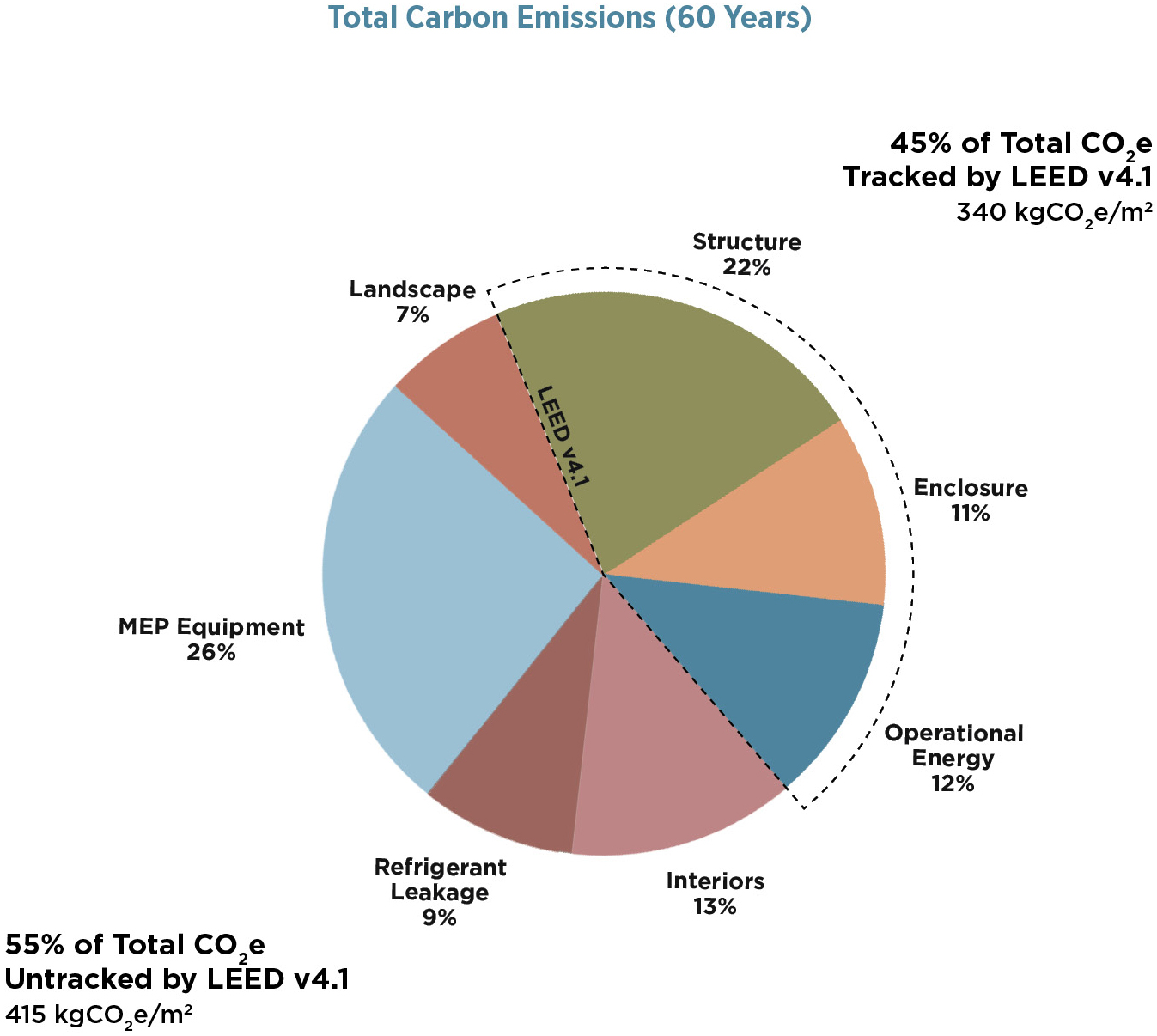
LMN, MKA, and PAE engineers analyzed the emissions from an advanced building, including Mass Timber structure and significant energy use reductions from high performance envelope and mechanical systems.
- Operational carbon from energy use *
- Embodied carbon emissions of structure and enclosure
- Embodied carbon emissions of interior partitions and finishes **
- Embodied carbon emissions related to landscape and sitework
- Embodied carbon emissions related to mechanical equipment
- Carbon dioxide equivalent emissions related to anticipated refrigerant leakage ***
* does not including time of use, which is relatively insignificant in this hydro-dominant region
** Optional in LEED’s Whole Building Life Cycle Assessment Credit
*** Refrigerant emissions reduction is part of a LEED credit, but the carbon equivalent emissions from leakage are not calculated
With substantial reductions in energy use emissions and structural embodied carbon, the study concluded that only about 45% of the total carbon emissions associated with this building were considered within the LEED system. This isn’t a knock on LEED – instead it shows that the industry has advanced more rapidly in the last few years and our rating systems need to catch up. If completed now, the team would include additional emissions sources, including energy time of use, initial site demolition and clearing, and the impacts associated with supporting infrastructure for water and energy systems.
Current Frameworks for Tracking Carbon Emissions
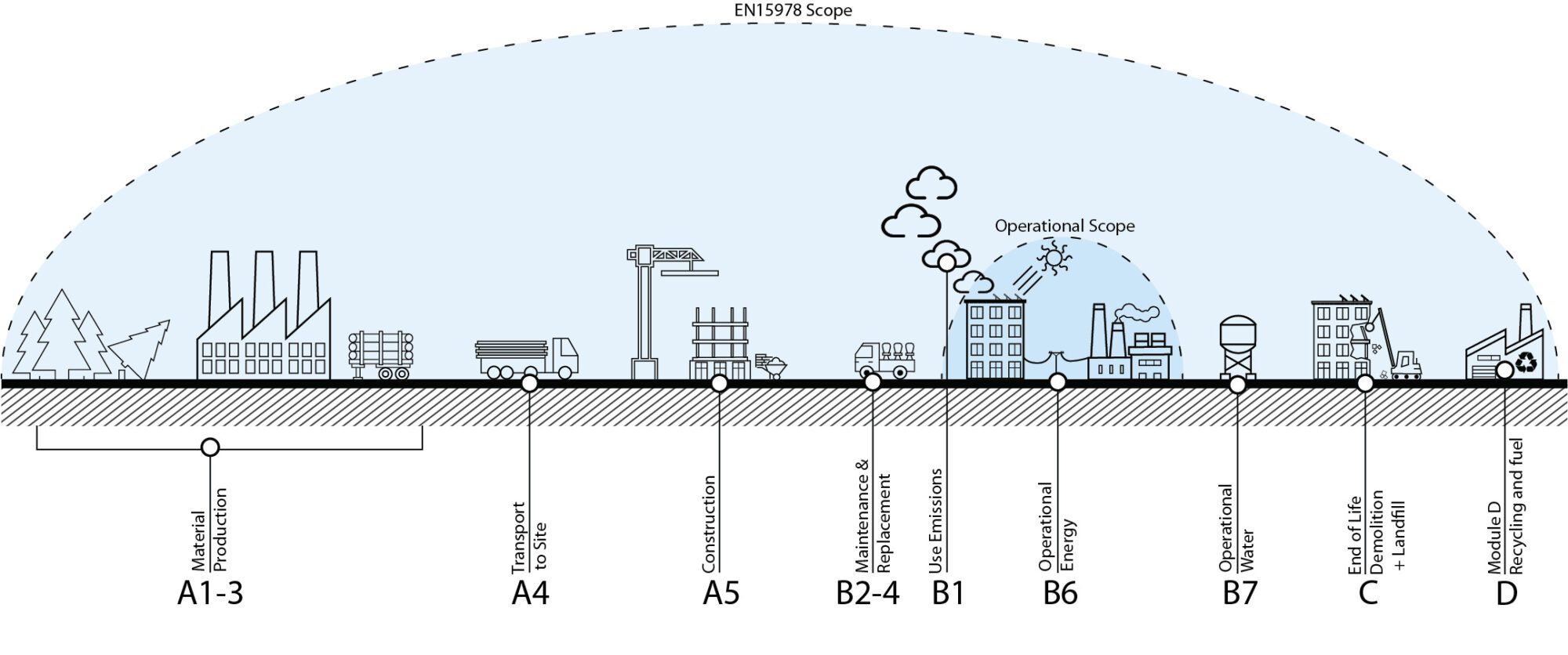
Currently, no frameworks include all emissions, but EN 15978 is the most comprehensive. It includes most energy uses as well as many impacts of construction and construction materials, from product creation through the product’s end of life. Analyses following EN15978 are often referred to as Whole Building Life Cycle Assessment (WBLCA) or, more simply, Life Cycle Assessment (LCA). This scope is organized into several ‘modules’ based on timeframe shown in the graphic above.
- A1-A5: Building Material creation, transportation, and installation on site
- B1-B5: Maintenance and replacement of building materials
- B6-7: Most operational Energy and Water Use carbon emissions
- C1-C4: Material end-of-life, including recycling, landfilling, or others
- D: Optional module showing environmental attributes beyond A-C stages
Most practitioners exclude many of the parts of EN 15978, meaning that while the framework is nearly comprehensive, most analyses done under the framework are not. Additionally, many areas covered by EN15978 don’t have robust data sets, so research efforts or tools like SE2050, MEP2040, NREL Cambium, TM65 (MEP), Pathfinder (Landscape), and GridOptimal are necessary to more thoroughly understand and reduce emissions in these areas. Lastly, EN 15978 is not a certification system, so calculations completed under it are not reviewed by a third party for consistency or minimum standards, making comparisons between projects difficult.
Examples of different frameworks for tracking carbon emissions include:
- EN15978 (described above)
- International Living Future Institute (ILFI) Zero Carbon Certification
- USGBC (LEED) Zero Carbon certification
- ASHRAE 228P “Standard Method of Evaluating Zero Net Energy and Zero Net Carbon Building Performance”
In addition to these frameworks, several other entities have attempted to define the scope of a comprehensive building impact study:
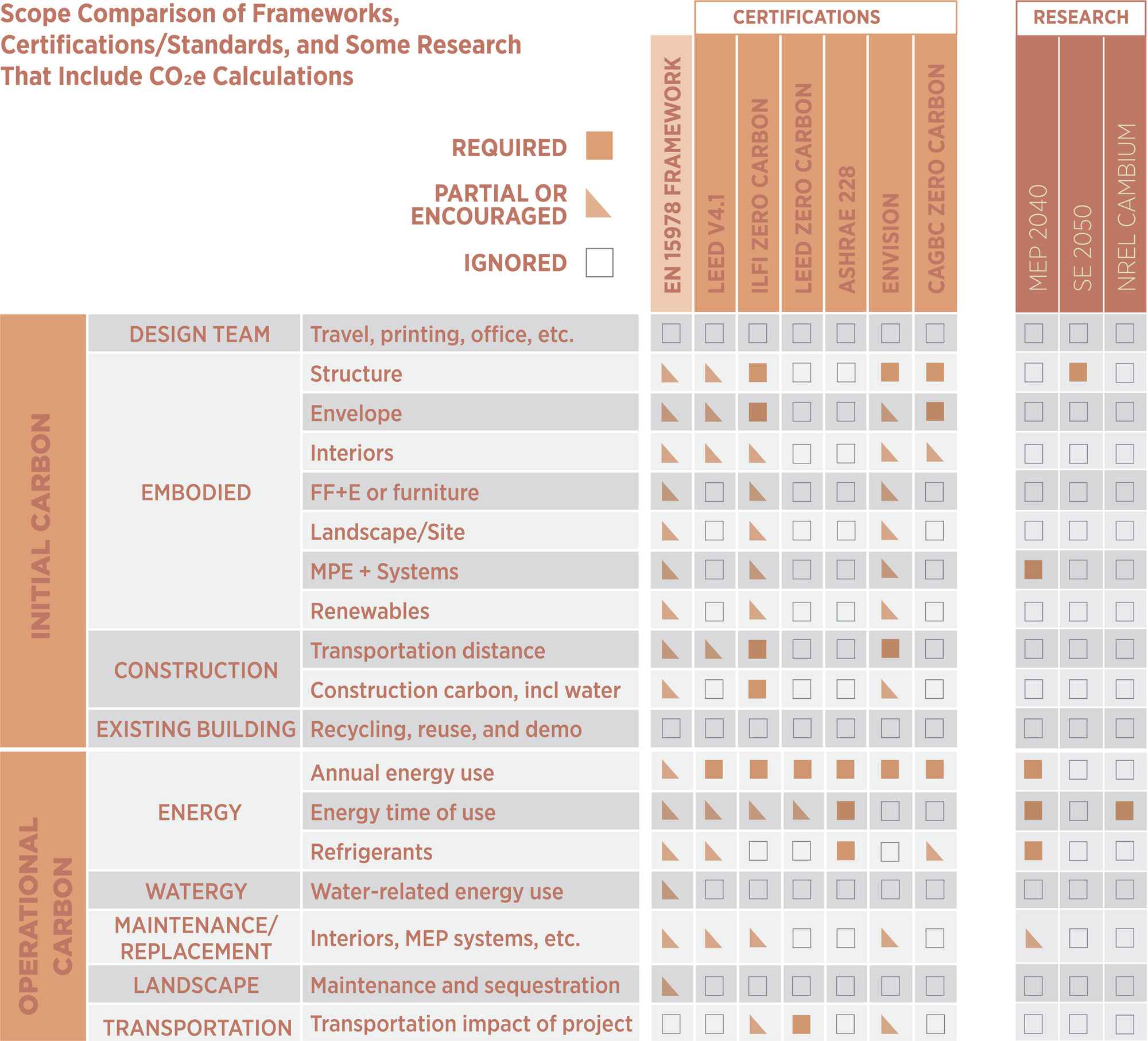
While many frameworks exist to target carbon emissions, no single framework captures the entire carbon story. Additional research is being performed by different professional groups to address gaps in the understanding of total carbon emissions remain.
Beyond EN15978
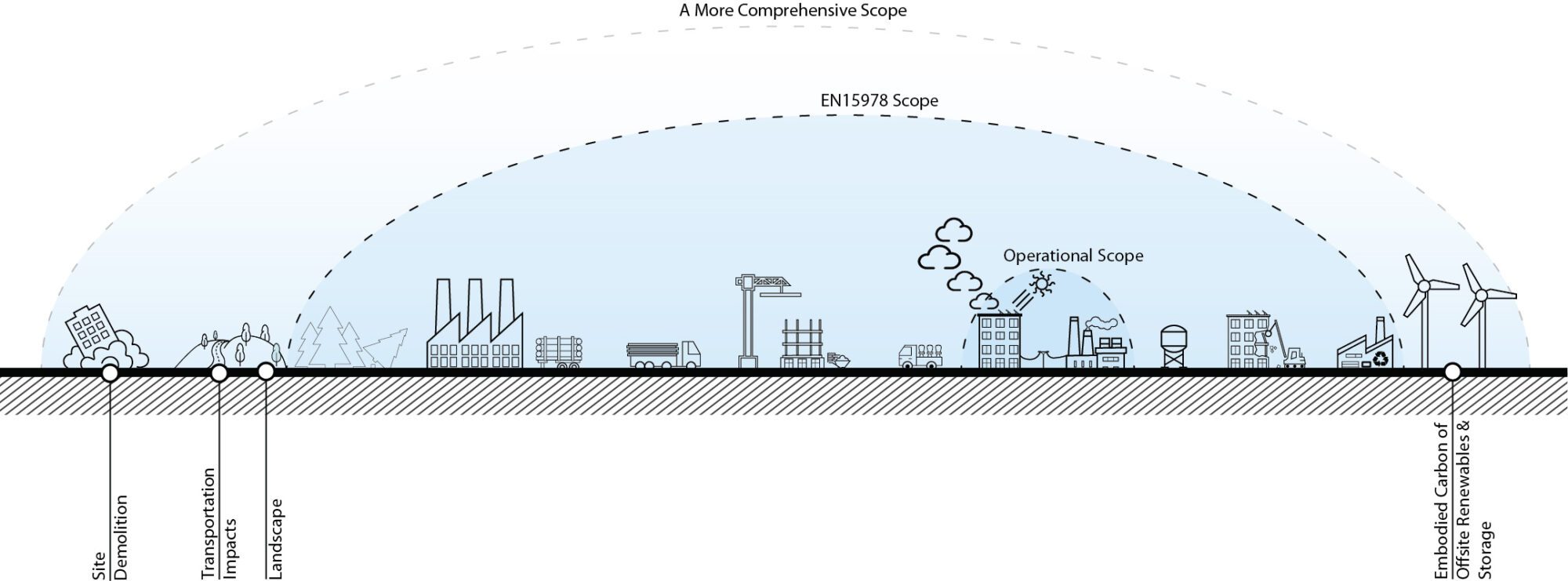
Even EN15978 excludes noticeable sources of carbon, so how do we understand what is or should be included in a comprehensive view? We need to reframe to ask the questions: What are all of the impacts the built environment has on the carbon balance of the land and oceans? What level of emissions from the built environment would be carbon neutral with regards to natural systems? From this point of view, a comprehensive carbon accounting should expand beyond EN15978’s limited timeframe, include consequential emissions instead of only attribution emissions, and include carbon offsets or removal that are necessary to balance emissions toward carbon neutrality.
The timeframe of a typical EN15978 study only includes the life of a building. On previously developed sites the project team will remove or modify the existing structure and sitework, and most of this activity is outside the study of an LCA performed to EN15978 standards. (This is to avoid double-counting since a prior study performed for the existing building would include the end of life of all materials already). The result is that calculations exclude the emissions and wasted carbon from razing buildings and sitework, creating demand for new products need to be produced to replace functional material. A more thorough ‘zero’ calculation would include extending the explored time frame to include the original building, giving project teams incentive to reuse existing structures either in full or in part. It also pulls end of life impacts of materials into immediate consideration – project teams have a direct effect on the existing material end of life, as opposed to relying on end-of-life scenarios set decades in the future.

While EN15978 includes emissions attributed to a building, the transaction of demolishing or rehabilitating a building and site more closely aligns with a design and construction team’s scope and influence.
Attributional emissions form the basis for EN15978 work, while consequential emissions are excluded. Attributional emissions are those directly associated with a product’s life cycle, within strict boundaries that allow for comparing emissions across similar products. However, in some notable cases attributional emissions exclude important considerations of the consequences of a choice that are outside the system boundaries, known as consequential emissions. For example, a project team has chosen to use fly ash as a supplemental cementitious material for a low-carbon concrete mix. The use of fly ash will lower the attributional impacts of the concrete. However, by continuing to demand fly ash for low-carbon mixes, the design community creates demand for this product: as a waste stream from coal-based energy production this may create a financial incentive to keep coal-fired electricity plants open, increasing carbon emissions. The boundary of consequential emissions is often difficult to define, but anyone attempting to claim zero carbon architecture should be aware that the consequential impacts can be substantial.
While finding all possible consequential emissions is infeasible, there are several important impacts that are commonly absent from carbon accounting:
- Transportation impacts of building users based on building siting and design
- Embodied carbon emissions from off-site renewable energy and storage demanded by new buildings
- Carbon emissions from displacement of other activities that occurred on site before demolition of existing buildings. For instance, if a small apartment building is demolished, are emissions increased by residents that now live farther for job centers?
Lastly, zero nearly always requires a negative carbon number since the act of building creates a carbon impact – these negative numbers often include biogenic carbon and carbon offsets. Both have the potential to reduce total atmospheric carbon, but their use in carbon accounting is controversial. Project teams striving for zero carbon architecture need to be aware of the arguments surrounding these topics and to clearly lay out any claims of negative numbers in their calculation, including the time frame anticipated for carbon sequestration. Post 08 explores this topic.
Data Quality + Accuracy
Claims of zero carbon architecture often assume an exact accounting of carbon emissions. Unfortunately, while energy modeling, embodied carbon modeling, and other analysis results may appear to be exact, they include uncertainty that is often not immediately clear in the results. Just because a result has 5 decimal places doesn’t mean it is accurate.
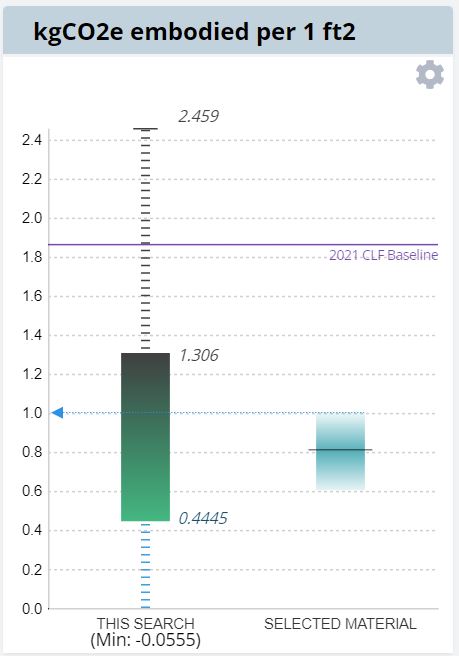
The free, online EC3 tools shows uncertainty within EPD data. Within the carpet tile category, a selected product (light blue) shows lines fading up and down to show the range of uncertainty within the EPD data, and suggests that the ‘best’ data to use is at the upper end of the uncertainty (1.0 kg/sf). Different products and EPDs have different levels of uncertainty. This can be compared to the green bar illustrating the 20% and 80% thresholds of all EPD data collected for this product type.
While energy modeling accuracy has drastically improved over the last 20 years, embodied carbon modeling has a wider range of uncertainty. Embodied carbon modeling, often called Life Cycle Analysis, combines quantity takeoff data from a building with material data from a Life Cycle Inventory (LCI) database or Environmental Product Declarations (EPDs) into a comprehensive view of carbon (and other) impacts of a building. Uncertainty occurs at several points within an LCA. Product stage (A1-A3) emissions data rely on historic averages, which may not reflect current conditions. In cases where factory specific emissions data is unavailable, EPD results may rely on industry average emissions data which can vary largely against site-specific conditions. This variation may be noted in the EPD text, but emissions numbers reported to an LCA are typically set as a single number along the uncertainty range. EPDs also rely on assumptions about the maintenance and replacement cycles and often include multiple disposal scenarios, which may not accurately reflect real-world conditions, especially conditions 20 or more years in the future.
Due to compounding uncertainties in LCI and EPD data, LCA should be presented as a range of possibilities rather than a single number. Post 07 explores how designers can still gain meaningful insights from data with wide confidence ranges. Unfortunately for those currently targeting zero carbon architecture, the uncertainties of underlying data suggest that even the most well-intentioned teams would be unable to determine an exact total carbon impact and that the zero-carbon claim should only be made using the most conservative estimates.
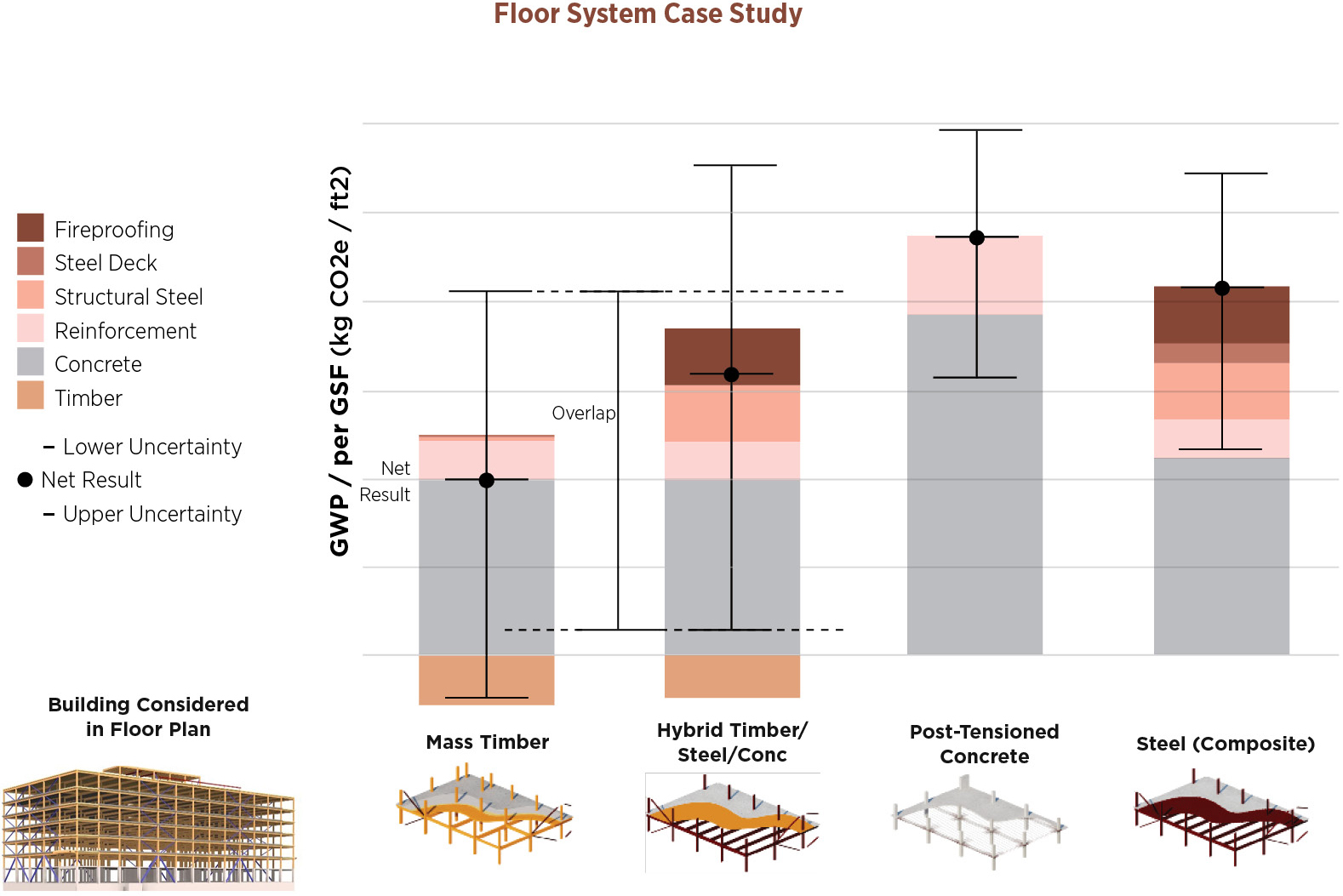
A comparison of major structural systems for a 6-story building, showing variation and uncertainty in possible carbon emissions outcomes based on the selected structural system. This shows that the highest-emitting Mass Timber structure is worse than the average hybrid structure. This means that even when lower carbon system is selected, teams still need to carry low-carbon design through specifications and procurement to realize the embodied carbon reduction. Image courtesy Don Davies of MKA Engineers.
Toward Zero Carbon Architecture
The AEC industry is working hard to identify and track its impacts and currently there is a need for additional, increasingly precise data. However, this should not stop our industry for targeting substantial reductions before the data is complete. While we believe that zero carbon architecture is potentially an impossible claim at the current moment, we believe this is an important goal to set. We think these are important considerations for carbon claims:
- Clarity of data – Results should be presented with uncertainty ranges, and net zero discussions should be based on conservate estimates. This should include disclosure of the type and scale of data used: industry averages, location-specific, or other.
- Clarity of scope – All Net Zero claims need to be made with study scope specifically identified, and any missing or excluded scope noted.
- Cast a wide net – To avoid ignoring carbon sources, teams should include as many sources of carbon as possible for their study.
- Disclose forward-looking data. Many important data sources, such as future electricity emissions based on NREL’s Cambium are very useful, but provide different results than using industry averages for current electricity emissions. Many products will be produced with increasingly renewable electricity, meaning that renovations within LCA studies need not assume the same embodied carbon as from materials produced today.
- Disclose the timeframe of the study and any carbon discount rate. Studies covering 20 years provide very different results than studies covering 60. Some studies include a method of prioritizing near-term emissions reduction, such as using a discount rate.
- Disclose any negative sources of carbon – biogenic and/or carbon offsets – to ensure that attempts to sequester carbon are additional, take place over a meaningful time frame, and are long lasting.
Having framed the question on what Zero Carbon Architecture should include, our next 5 posts will dive into the science and accounting necessary to discuss actionable steps for our industry.
Please email any questions or comments to Kjell Anderson, kanderson@lmnarchitects.com
Thanks to our external collaborators and peer reviewers
Vincent Martinez, Arch 2030; Kristian Kicinski, Bassetti Architects; David Mead, PAE Engineers; Harry Flamm, Stantec
LMN Architects Team
Huma Timurbanga, Justin Schwartzhoff, Jenn Chen, Chris Savage, Andrew Gustin, Kjell Anderson
Posted: 06/16/2022
The text, images and graphics published here should be credited to LMN Architects unless stated otherwise. Permission to distribute, remix, adapt, and build upon the material in any medium or format for noncommercial purposes is granted as long as attribution is given to LMN Architects.